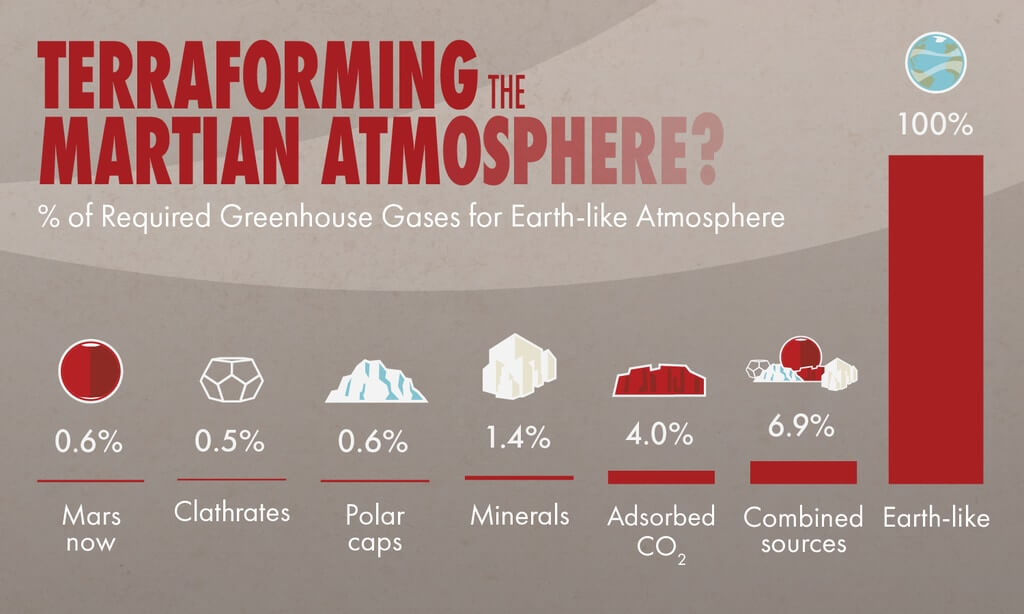Autonomous silicon dioxide airgel designs will create local habitable zones on Mars with habitual positive temperatures, enough light for photosynthesis and environment safe from harmful ultraviolet radiation.
Such a regional approach to the terraforming of Mars is much more achievable than the global change of its atmosphere. Unlike previous ideas to make the Red Planet fit for life, our approach can be systematically improved and tested using materials and technologies that are available to us today.
-Robin Wordsworth, lead author of a study from Harvard University (USA)
For many decades, mankind has been dreaming of changing the Martian climate to make it livable. The first who proposed a scientific approach to the terraforming of Mars was the American astronomer Karl Sagan, who described in his 1971 paper the idea that evaporation of the ice caps of the North Pole might increase the global temperature on the planet due to the greenhouse effect and significantly increase the likelihood of liquid tanks. water
Carl Sagan’s research encouraged other astronomers and scientists to take seriously the idea of creating an inhabited Mars, and the key point of recent times was the question: is there enough greenhouse gases and water on it to increase atmospheric pressure to a level similar to Earth? Unfortunately, in 2018, scientists showed that it was impossible to increase atmospheric pressure in this way to the required level, and it seemed that the terraforming of Mars would remain a pipe dream for us.
However, now researchers at Harvard University, NASA’s Jet Propulsion Laboratory and the University of Edinburgh (UK) have a new idea. Instead of trying to change the whole planet, they chose a regional approach.
Scientists suggest that certain areas of the surface of the Red Planet could be made habitable using silica airgel that simulates the atmospheric greenhouse effect of the Earth. Through simulation and experimentation, researchers found that a screen made from this material with a thickness of two to three centimeters can transmit enough visible light for photosynthesis, block dangerous ultraviolet radiation and constantly maintain the temperature above zero, all without the need for any internal heat source.
Mars is the most inhabited planet in our solar system after Earth. But today it still remains a hostile world for many kinds of life. The system of creating small habitable islands will allow us to transform Mars in a controlled and scalable way.
-Laura Kerber, co-author of the study from NASA’s Jet Propulsion Laboratory
Scientists note that their study was inspired by the natural process that takes place on modern Mars.
Unlike polar ice caps of the Earth, which consist of frozen water, their counterparts on the Red Planet are a combination of water ice and frozen carbon dioxide. Like its gaseous form, frozen carbon monoxide allows sunlight to penetrate, keeping it warm. In the summer, such a “solid-state greenhouse effect” creates warm foci under the ice.
We began to think about this process and how it can be used to create a habitable environment on Mars. First of all, we needed to find a material that passes a lot of light and at the same time keeps heat well.
-Robin Wordsworth
As a result, the authors of the work focused on silicon airgel, one of the most insulating materials ever created. He, according to scientists, is extremely promising when creating local foci of life on Mars, since it does not require much energy or maintenance and can keep the area enclosed under it warm for a long period of time.
Silicon dioxide airgel can be used to build residential domes or even autonomous biospheres on Mars. Now we are planning to conduct field tests and test the material in the “Martian” conditions of Antarctica or Chile.
Scientists have figured out how to inhabit Mars
Click To Tweet
The post Scientists have figured out how to inhabit Mars appeared first on Upcosmos.com.
